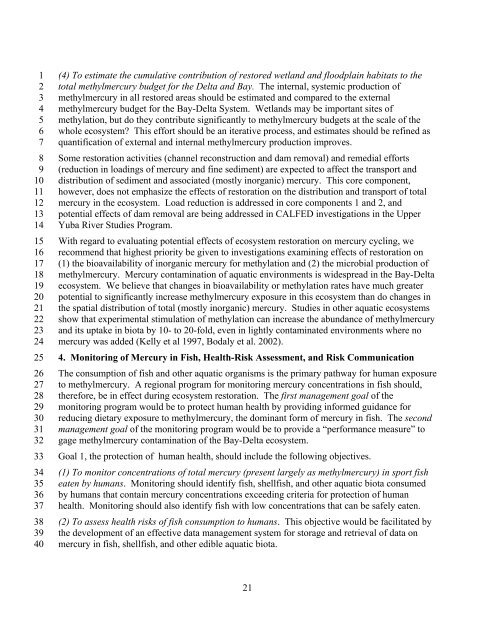Mercury Strategy for the Bay-Delta Ecosystem - CALFED Bay-Delta ...
Mercury Strategy for the Bay-Delta Ecosystem - CALFED Bay-Delta ...
Mercury Strategy for the Bay-Delta Ecosystem - CALFED Bay-Delta ...
Create successful ePaper yourself
Turn your PDF publications into a flip-book with our unique Google optimized e-Paper software.
1<br />
2<br />
3<br />
4<br />
5<br />
6<br />
7<br />
8<br />
9<br />
10<br />
11<br />
12<br />
13<br />
14<br />
15<br />
16<br />
17<br />
18<br />
19<br />
20<br />
21<br />
22<br />
23<br />
24<br />
25<br />
26<br />
27<br />
28<br />
29<br />
30<br />
31<br />
32<br />
33<br />
34<br />
35<br />
36<br />
37<br />
38<br />
39<br />
40<br />
(4) To estimate <strong>the</strong> cumulative contribution of restored wetland and floodplain habitats to <strong>the</strong><br />
total methylmercury budget <strong>for</strong> <strong>the</strong> <strong>Delta</strong> and <strong>Bay</strong>. The internal, systemic production of<br />
methylmercury in all restored areas should be estimated and compared to <strong>the</strong> external<br />
methylmercury budget <strong>for</strong> <strong>the</strong> <strong>Bay</strong>-<strong>Delta</strong> System. Wetlands may be important sites of<br />
methylation, but do <strong>the</strong>y contribute significantly to methylmercury budgets at <strong>the</strong> scale of <strong>the</strong><br />
whole ecosystem? This ef<strong>for</strong>t should be an iterative process, and estimates should be refined as<br />
quantification of external and internal methylmercury production improves.<br />
Some restoration activities (channel reconstruction and dam removal) and remedial ef<strong>for</strong>ts<br />
(reduction in loadings of mercury and fine sediment) are expected to affect <strong>the</strong> transport and<br />
distribution of sediment and associated (mostly inorganic) mercury. This core component,<br />
however, does not emphasize <strong>the</strong> effects of restoration on <strong>the</strong> distribution and transport of total<br />
mercury in <strong>the</strong> ecosystem. Load reduction is addressed in core components 1 and 2, and<br />
potential effects of dam removal are being addressed in <strong>CALFED</strong> investigations in <strong>the</strong> Upper<br />
Yuba River Studies Program.<br />
With regard to evaluating potential effects of ecosystem restoration on mercury cycling, we<br />
recommend that highest priority be given to investigations examining effects of restoration on<br />
(1) <strong>the</strong> bioavailability of inorganic mercury <strong>for</strong> methylation and (2) <strong>the</strong> microbial production of<br />
methylmercury. <strong>Mercury</strong> contamination of aquatic environments is widespread in <strong>the</strong> <strong>Bay</strong>-<strong>Delta</strong><br />
ecosystem. We believe that changes in bioavailability or methylation rates have much greater<br />
potential to significantly increase methylmercury exposure in this ecosystem than do changes in<br />
<strong>the</strong> spatial distribution of total (mostly inorganic) mercury. Studies in o<strong>the</strong>r aquatic ecosystems<br />
show that experimental stimulation of methylation can increase <strong>the</strong> abundance of methylmercury<br />
and its uptake in biota by 10- to 20-fold, even in lightly contaminated environments where no<br />
mercury was added (Kelly et al 1997, Bodaly et al. 2002).<br />
4. Monitoring of <strong>Mercury</strong> in Fish, Health-Risk Assessment, and Risk Communication<br />
The consumption of fish and o<strong>the</strong>r aquatic organisms is <strong>the</strong> primary pathway <strong>for</strong> human exposure<br />
to methylmercury. A regional program <strong>for</strong> monitoring mercury concentrations in fish should,<br />
<strong>the</strong>re<strong>for</strong>e, be in effect during ecosystem restoration. The first management goal of <strong>the</strong><br />
monitoring program would be to protect human health by providing in<strong>for</strong>med guidance <strong>for</strong><br />
reducing dietary exposure to methylmercury, <strong>the</strong> dominant <strong>for</strong>m of mercury in fish. The second<br />
management goal of <strong>the</strong> monitoring program would be to provide a “per<strong>for</strong>mance measure” to<br />
gage methylmercury contamination of <strong>the</strong> <strong>Bay</strong>-<strong>Delta</strong> ecosystem.<br />
Goal 1, <strong>the</strong> protection of human health, should include <strong>the</strong> following objectives.<br />
(1) To monitor concentrations of total mercury (present largely as methylmercury) in sport fish<br />
eaten by humans. Monitoring should identify fish, shellfish, and o<strong>the</strong>r aquatic biota consumed<br />
by humans that contain mercury concentrations exceeding criteria <strong>for</strong> protection of human<br />
health. Monitoring should also identify fish with low concentrations that can be safely eaten.<br />
(2) To assess health risks of fish consumption to humans. This objective would be facilitated by<br />
<strong>the</strong> development of an effective data management system <strong>for</strong> storage and retrieval of data on<br />
mercury in fish, shellfish, and o<strong>the</strong>r edible aquatic biota.<br />
21

















